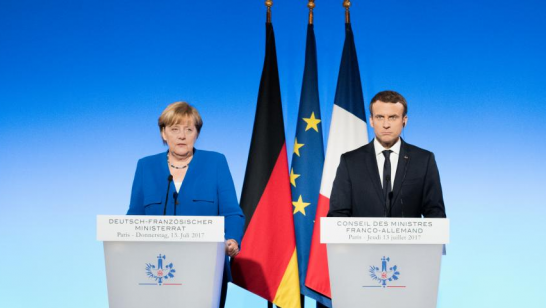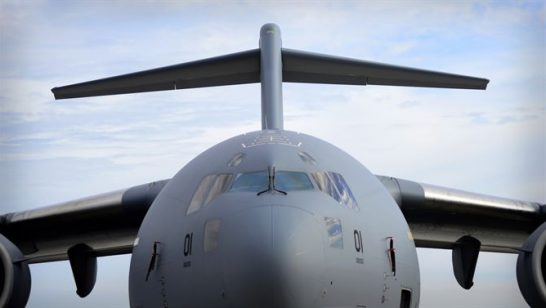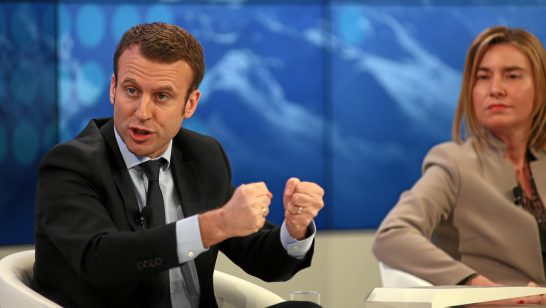
In his 26 September address on Europe and the newly released Strategic Review of Defence and National Security, French President Emmanuel Macron outlined his ambitions for the European Union in the field of defence. With the objective of developing a “common strategic culture”, Macron suggested that by the next decade, “Europe” should develop a European Intervention Initiative, with a common doctrine, and common budgetary instruments. The logic is far from flawed, but achieving convergence does require concrete arrangements and decisions if it is to foster fruitful links among military communities. What is more, there remain a number of aspects to clarify about the French intention.
Specifying the Ambition
Like in any matter of strategy, setting out the endgame is a necessary starting point for achieving joint efforts. Specifying the ambition means defining the purpose, size and nature of the force or Initiative.
France and the United Kingdom developed between 2010 and 2016 a Combined Joint Expeditionary Force (CJEF) from which some lessons can be learned. Defining the purpose of the CJEF did not present any kind of problems in this particular case due to a prior agreement on its expeditionary role, based on the shared experience and strategic culture of French and British militaries. Agreeing on its size was a matter of bilateral negotiations however, as France and the UK had different initial ambitions. Eventually, the smaller option of ‘battlegroups’ was chosen. As for the nature of the CJEF, there was an agreement on both sides that it would not be a permanent force nor have specific forces assigned to it. In other words, the CJEF would in fact be merely “books of procedures” that would allow British and French national high readiness forces to operate together when necessary.
When it comes to a potential European Intervention Initiative, the same questions have to be addressed. In terms of purpose, the French Strategic Review suggests that it should help foster interoperability in all the scenarios in which Europeans are engaged. Now, the amount of work needed for strategic culture convergence – and the probability of ever achieving it – differs whether we talk about defensive missions of the types that are conducted in the north and east of Europe, expeditionary missions of the type France leads in Africa, or peacekeeping and civil-military ones of the type the EU is used to overseeing. In a speech at the Center for Strategic International Studies (CSIS) in Washington D.C. on 20 October, the Minister for the Armed Forces Florence Parly specified that France is aiming for a “quick and operational force” that could undertake missions such as the one France has conducted in Mali. It thus looks like France is pursuing the more demanding goal of strategic culture convergence necessary for quick multinational deployments in semi-permissive operational environments.
That leads us to the second question, the matter of size; not so much – yet – the number of brigades it could comprise, but how many European states would be involved. Surely, it would be unrealistic to expect the same level of cultural rapprochement among all European member states, especially around expeditionary missions. Permanent Structured Cooperation (PESCO), which was originally meant to foster cooperation around a core number of countries more willing and able, has just been agreed on in a broad and inclusive version – which corresponds more to the German model. The ambitious “avant-garde” tool from the Lisbon treaty has turned into a framework with 23 (probably soon 25) member states, hence far away from what the French had originally envisioned. PESCO is also centred more on capability projects than on operational cooperation, strategic cultures, and doctrines. This means that PESCO is unlikely to be used for deployment: hence Macron’s Intervention Initiative could potentially provide an operational replacement for what the now inclusive PESCO framework won’t be able to deliver. If it is to be an EU project, the Initiative could be developed either outside of the PESCO framework, or as a sub-branch of it: an “Ad Hoc Co” within PESCO.
As for its participants, Parly explained at the CSIS, France is primarily counting on her traditional allies: Germany, Italy and Spain, who are concerned with current security developments south of Europe. However, given its expeditionary purpose, the force should arguably include other suitable (future) non-EU partners and NATO allies, especially the UK and Norway, or those with opt-outs like Denmark. And, of course, it should be inter-operable with the United States, who is one of France’s key partners in Africa.
Organising cooperation
Developing a multinational force concept involves several phases: identifying stakeholders and connecting them, specifying the objective, assessing the initial level of interoperability, designing concepts and doctrines, and conducting exercises to validate or amend procedures. This takes several years and requires a governance structure.
The CJEF’s development was supervised by a Steering Committee composed of the Vice-Chiefs of the Defence Staff that oversaw working groups whose work was coordinated by a small secretariat. A problem France and the UK faced with the series of exercises they conducted was resource constraint: exercises require a lot of planning, and available troops and infrastructures. France and the UK often had to organise their training on the side of multinational NATO exercises for that reason, but nonetheless they sometimes lacked troops due to ongoing deployments. Financial and human resources for training will thus be a key issue to solve when developing the European Initiative.
Now, who would oversee the European Initiative? The CJEF is bilateral, and the UK-led Joint Expeditionary Force (JEF) – an initiative with Denmark, Estonia, Finland, Latvia, Lithuania, the Netherlands, Norway and Sweden stemming from shared experiences in Afghanistan – follows NATO’s Framework Nation Concept. We do not know what would be the shape of power relations in Macron’s European intervention force. Will Berlin offer Paris a blank check to take the lead in shaping the future of a European expeditionary military capacity? Given Paris and Berlin’s different approaches to the use of force, a joint leadership would lead to a tug-of-war, especially if the Force is conceived for missions other than peacekeeping and/or territorial defence.
Nonetheless, a form of leadership is necessary, whether it comes from France, jointly from Paris and Berlin, or from a steering committee composed of appointed top-ranking military representatives from various countries. The latter would surely be desirable, so that decisions are made which reflect military realities rather than politics. So far, the French government has referred to ‘Europe’ and ‘Europeans’ when presenting the Initiative, thus opening the way to the creation of innovative governance structure. Arguably, conceiving the Initiative as independent from the EU’s Military Committee and Staff would allow the creation of a more flexible, adaptable and responsive governance structure, although it would lead to new questions regarding budgets, infrastructures and training.
Building on the ‘acquis’
Developing the body of doctrine and procedures for a European Intervention Initiative from scratch would be a daunting task and would make little sense. Thankfully, the Initiative can build on the acquis of NATO, the EU and other bilateral or “minilateral” initiatives.
The EU already relies significantly on NATO doctrines and procedures that it has been transposing, all the more so since NATO has been fast in adapting to new types of missions, including Peace Support Operations. In order to not waste time and energy by starting from scratch and to maintain interoperability across Europe, I argue that only when NATO doctrines and procedures are lacking or inappropriate should new documents be produced. In other words, while a European Initiative could be organically independent from NATO, its development should not occur without coordinating with and taking advantage of NATO. Minister Parly actually suggested it could be “combined” to NATO, although the institutional set up for it remains to be specified.
Besides, given the expeditionary purpose and the likely nature of France’s project, the procedures developed with the CJEF and the JEF could be very useful as complementary baselines for the force’s doctrines and procedures.
Building on the acquis also means sustaining cooperation over time. Whether a European intervention force concept can be developed within three years as hinted by Macron is very doubtful, and whether it is desirable also is. In fact, setting a longer-term goal and maintaining a high level of activity and a high density of exchanges over several years is what is necessary to convergence, but also to solidify the new acquis after the Initiative is complete.
Finally, a priority will be to ensure the Initiative will have the necessary capabilities in the future, by filling Europe’s gaps, which are worst in the areas of air-to-air refuelling, intelligence, command & control, strategic reconnaissance, transport and medical and logistics support. Europeans cannot be strategically autonomous without these capabilities. Procuring or developing these capabilities will take much more time that what Macron envisages, so, if the Initiative indeed ends up being affiliated to the EU, the Berlin + process could be used in the meantime to provide access to some of NATO’s capabilities, while the extension of the EU’s Athena mechanism could help fund the missions’ logistics and support. It is likely that potential stakeholders like Germany would support such an option. EU High Representative Federica Mogherini as well could make the case for the initiative to become a new topic of EU-NATO cooperation, something which she has been working on significantly since the beginning of her mandate.
Current regional dynamics political are favourable to greater commitments to European defence. France’s announcement of the European Intervention Initiative, however, has not prompted many public reactions at this stage, so it is difficult to know how much France’s partners are going to buy into it. The risk is that much political and bureaucratic energy will be absorbed by the PESCO project, leaving few resources available for that initiative in the short term. And the institutional affiliation of this initiative remains to be specified. The CJEF precedent teaches us that initiatives that are developed outside of NATO and the EU are difficult to plug into regional institutions once they already exist. And while they are more flexible and thus potentially more effective, they are also more prone to fluctuate according to domestic political dynamics than when they are fully institutionalised. Finally, affiliating the Initiative to the EU (or double-hatting it with NATO) would make sense to allow access to infrastructures, funding and capabilities, but the risk would be that some member-states could be wary of being left out. This, in turn, would make the goal of effectiveness and strategic culture convergence even harder to reach.
The opinions articulated above represent the views of the author(s), and do not necessarily reflect the position of the European Leadership Network or any of its members. The ELN’s aim is to encourage debates that will help develop Europe’s capacity to address the pressing foreign, defence, and security challenges of our time.



